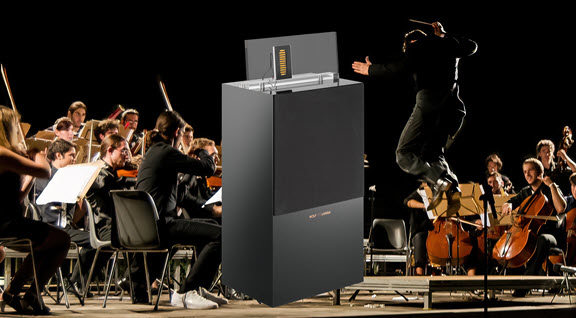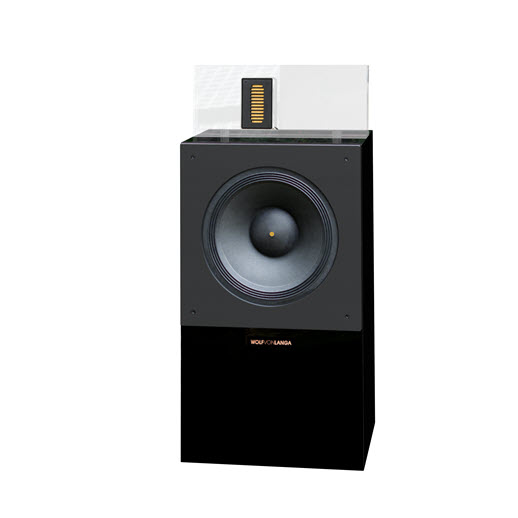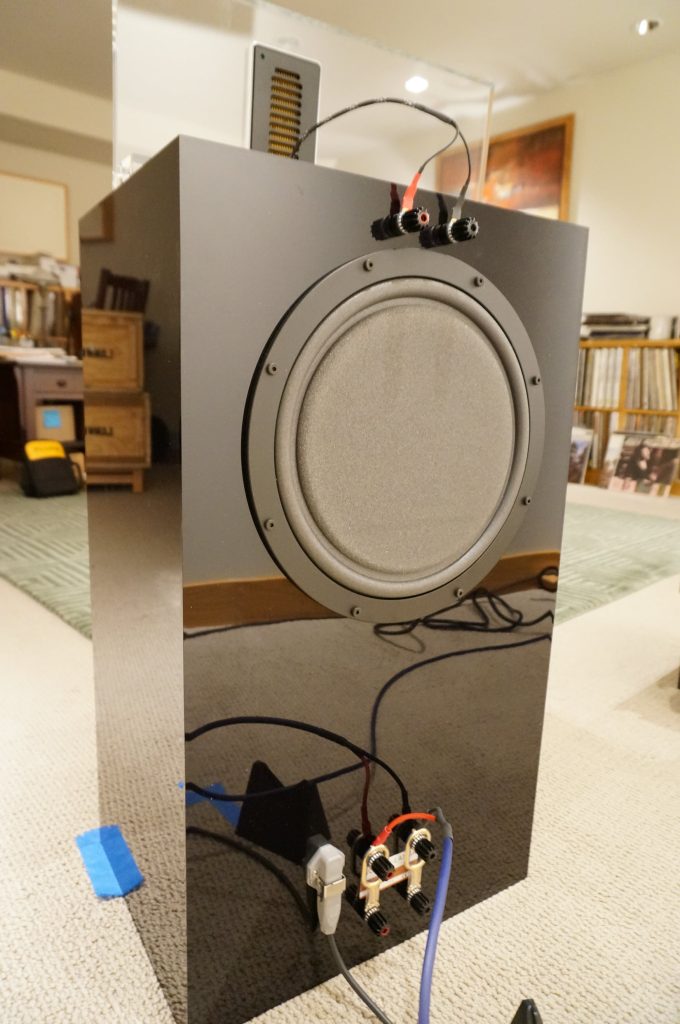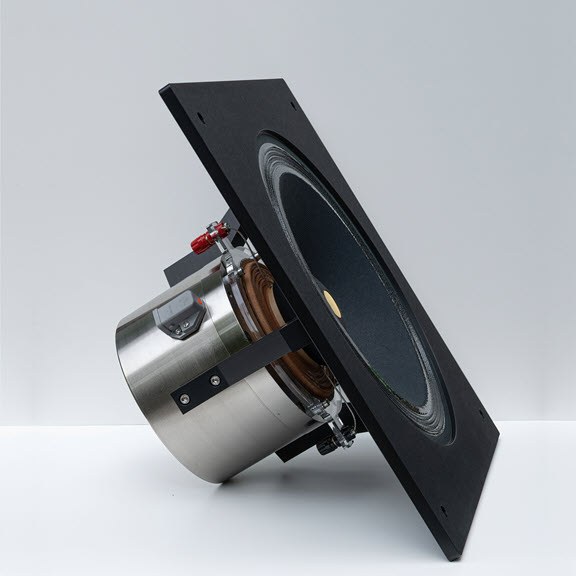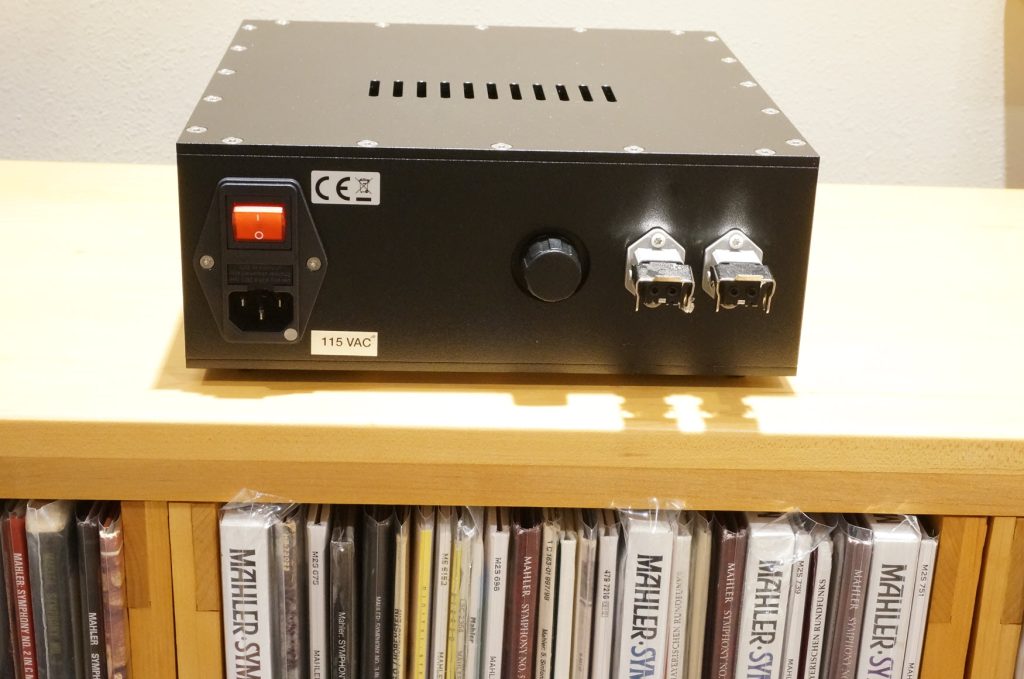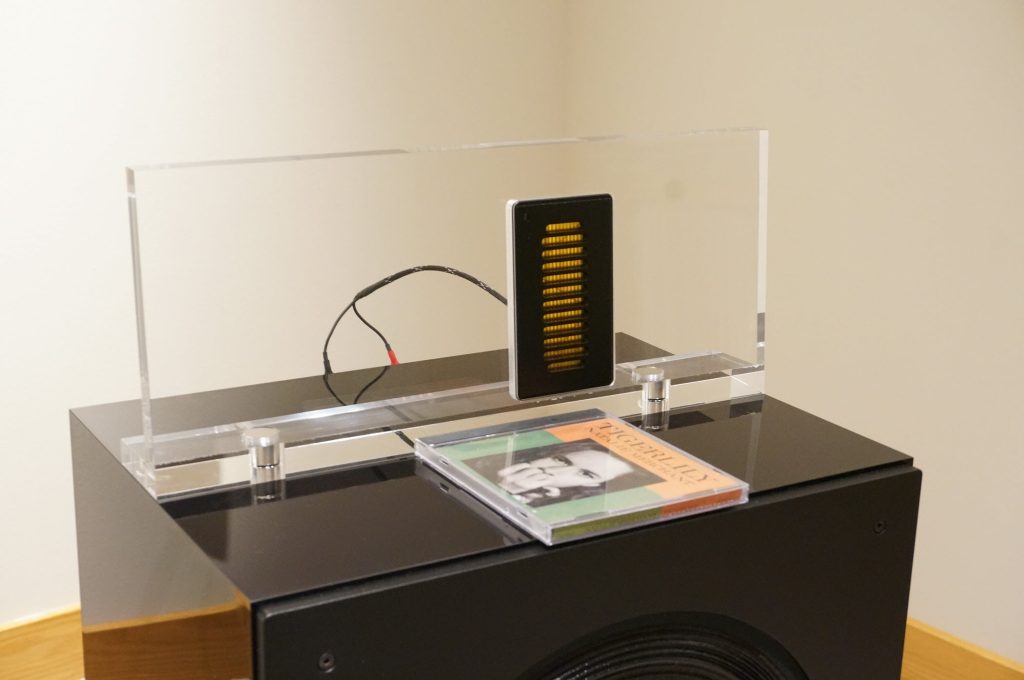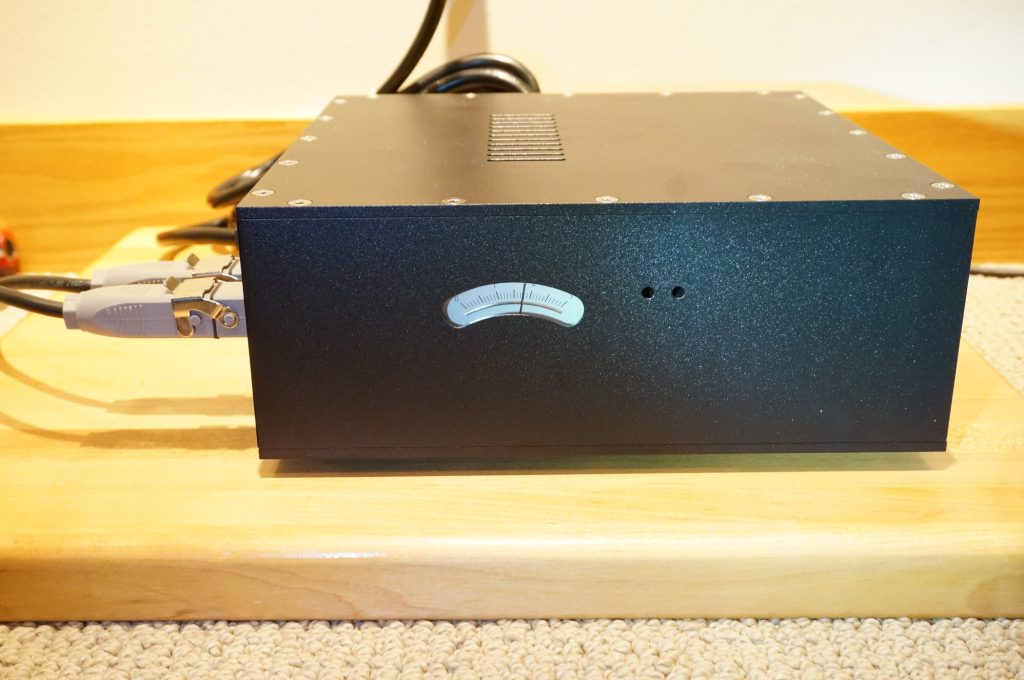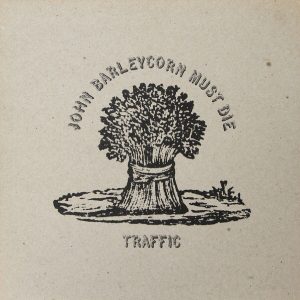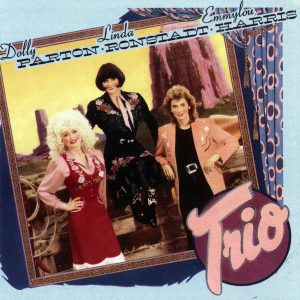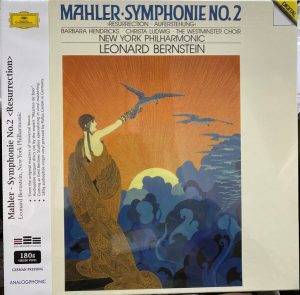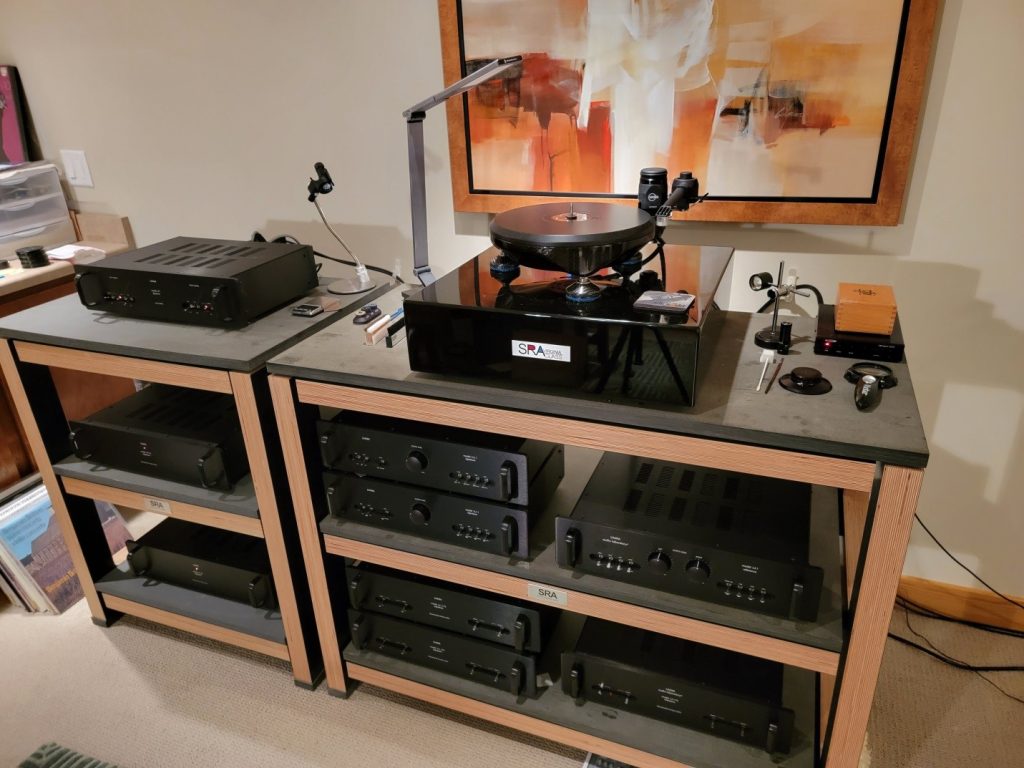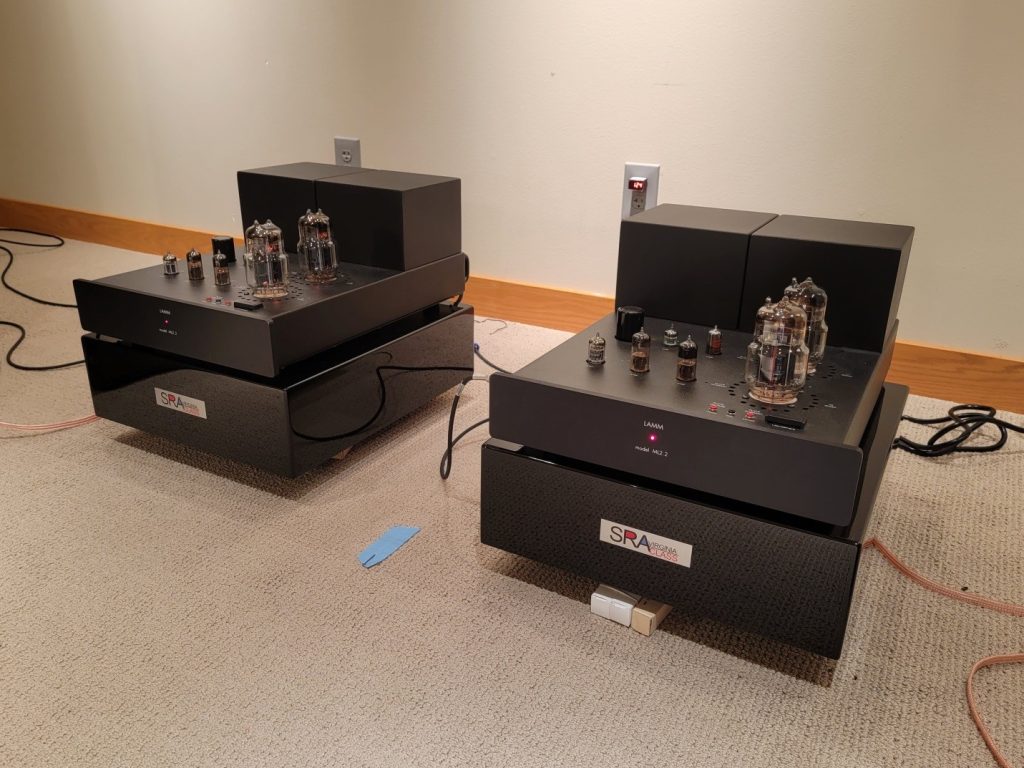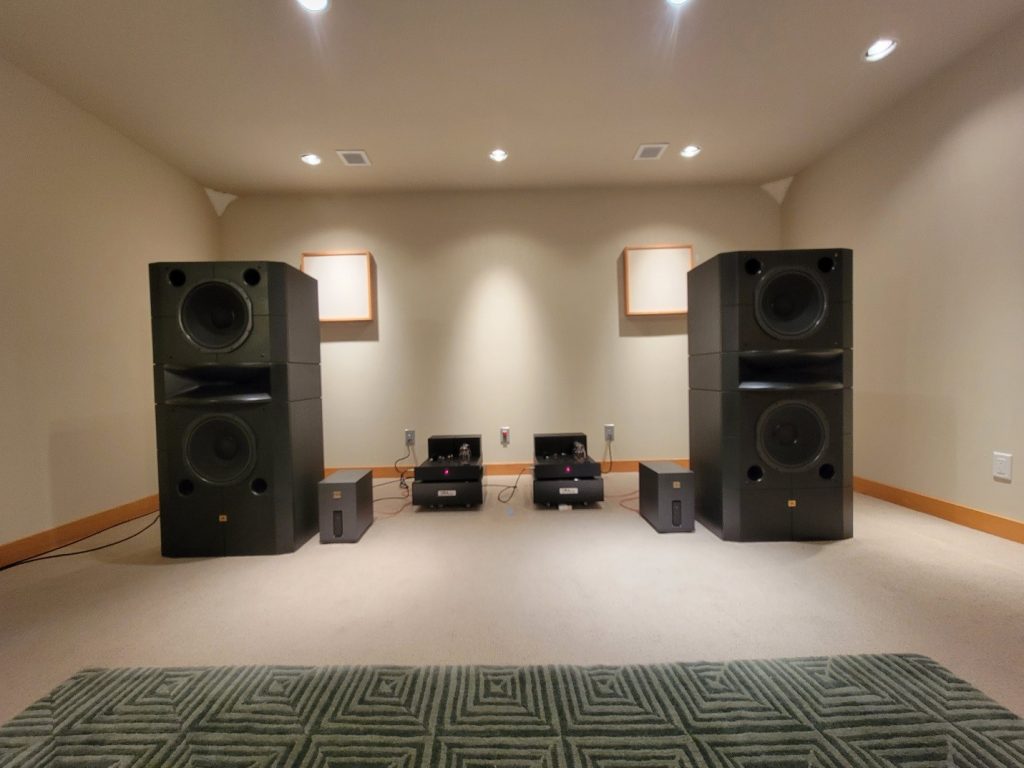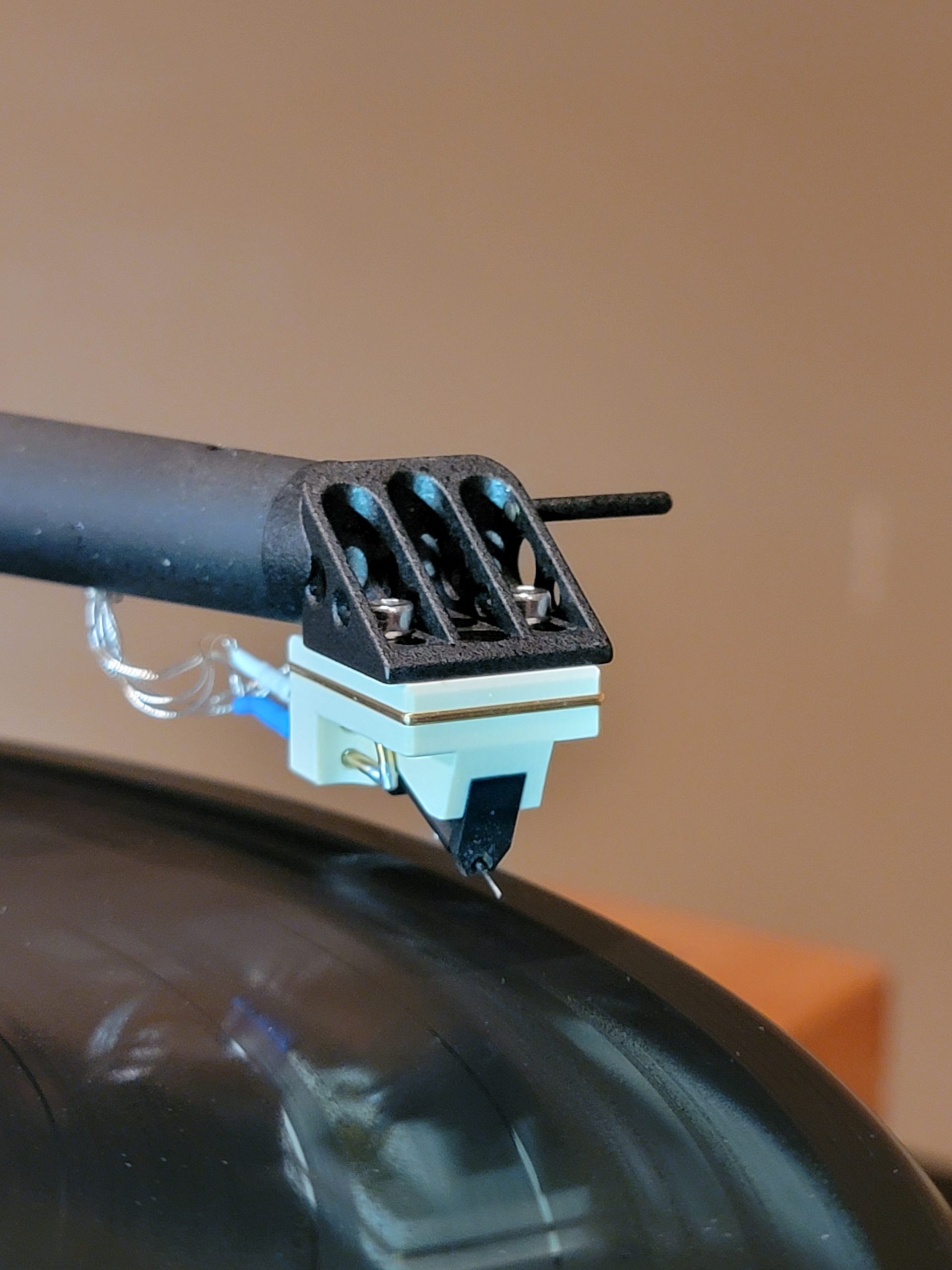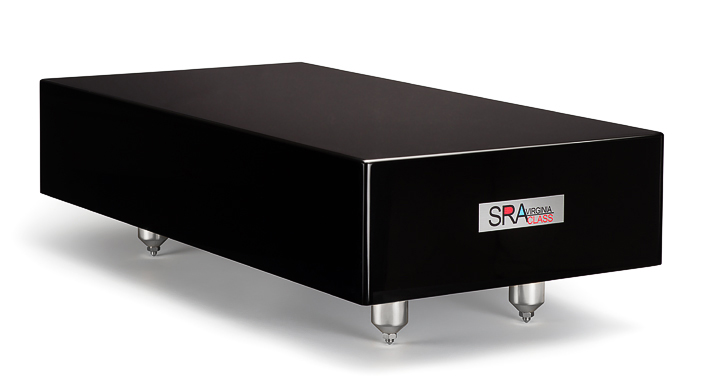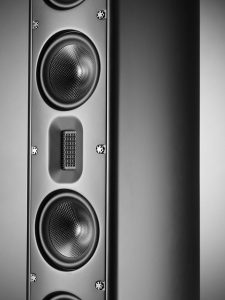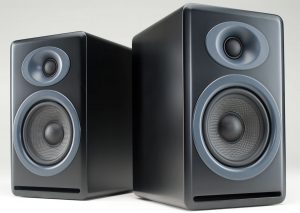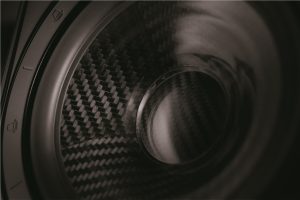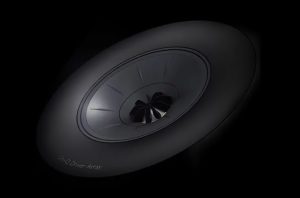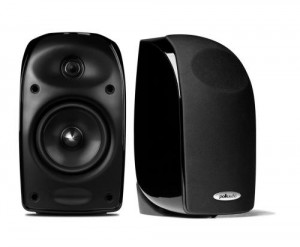The SON also Rises
The name Wolf von Langa (WVL) is known in Germany as a manufacturer of high-end audio speakers. Unless you are up on the European speaker scene, the brand may be new to you.
Here's a little background about Herr von Langa, the man: After making his very first speaker at age 14 and his first horn system at 16, Wolf von Langa spent time building digital studios. He was involved in opening high-end audio shops. After a multi-year apprenticeship studying the history of speaker design, manufacturing, and materials dating from the movie systems of the 1940's through the present day, von Langa came to the conclusion that "…the technology applied to music reproduction stopped in the 60s." He turned himself into a developer and manufacturer. Around 2009, von Langa started a company making high and low frequency field-coil compression drivers and field-coil power management systems.
After three years of manufacturing speaker drivers, von Langa began making complete speaker systems. From the company Web site: All Wolf von Langa loudspeakers are highly-developed systems which are designed and built by us entirely. We use only the highest-grade materials, assembling and calibrating each unit manually in Germany. Near the start of 2021 von Langa entered into a partnership with Colin King, owner of Gestalt Audio Design in Nashville Tennessee who is now the US distributor for Wolf von Langa.
When I started this review project, WVL offered four different speakers in their lineup using field-coil drivers in their mid-woofers and woofers. Since then they've added two permanent magnet models. Drawing on successful speaker designs from the past, their four top-tier models include: the AUDIO FRAME LONDON (1930's Voigt-style full range driver, msrp $56,995), the AUDIO FRAME CHICAGO (implementing a version of the Western Electric 755 paired with an AMT tweeter, $61,995), and the AUDIO FRAME BERLIN (inspired by the legendary Siemens Klangfilm horns, $88,995). Von Langa indicates that he bases the pricing for his product range on manufacturing costs, not distinct tiers of quality or sound. Von Langa believes that whichever model you choose it will reflect the company's motto: "No one will ever want more loudspeaker."
The fourth model, our review subject, is the WVL 12639 SON ($17,995 USD) introduced in 2015 and substantially revised in 2017. The SON (pronounced 'sohn,' based on the Spanish word for "sound") is a two-way design utilizing a field-coil mid-woofer paired with an externally mounted dipole Air Motion Transformer (AMT) tweeter and a passive rear radiator. To power the magnets in the field-coil speakers, the SONs come with an external variable-current power supply with a user-adjustable potentiometer, gauge, and power cables. Warranty is 5 years upon registration.
Technological Flexibility
I found the WVL SONs offering a variety of options for working within an existing audio system. Once broken-in they sound enjoyable with even casual positioning yet they offer considerable flexibility for fine tuning them to your preferred sound and listening space. Let's examine the SON closely.
Basic Specifications
The speaker has a nominal impedance of 8 Ohms with 94dB (1w/1m) efficiency and is capable of handling 150 watts continuous power with a 1500 watt peak power (10ms) rating. Frequency response is 25Hz to 25000Hz +/- 3dB. Different from the many lower efficiency speakers on the market today, the SONs are usable equally with low or high power amplifiers. This allowed me to review them with a low wattage SET amplifier and a 110 Watt solid state amplifier—more on these later.
Speaker
The SON is a two-way model with a combination electromagnetic midrange-bass driver and a dipole tweeter. The mid-woofer is a stiff lightweight cellulose cone sized at ~10.5 inches. Unlike the typical rubber or foam suspension that connects the cone to its baffle (and is apt to dry, harden, and weaken over time) the SON uses a soft textile canvas with multiple small folds soaked in a tar-like material that does not dry out. It's sticky, you do not want to touch it. The idea is a free moving diaphragm with a long life that reduces coloration. The suspension directly attaches to a very substantial 0.4" thick, 15¾" square, aluminum baffle that dominates the entire upper portion of the speaker's face. On the inside, thick metal brackets bolted to that baffle support a beefy 42lb Wolf von Langa field-coil driver fixed to the cone. If you are unfamiliar with field-coil speakers, read on.
Cabinet
Von Langa embraces a Bauhaus style, adopting simple geometric shapes without fancy decoration. The cabinet that houses the mid-woofer is high-density fiberboard with a strong lightweight thermoplastic waterproof coating of PMMA (Polymethylmethacrylate), polished to a glass-like sheen. Wood veneers are also available at additional cost. As a simple rectangle, the smallish SON measures approximately 27.5"H x 16"W x 12"D and weighs 93lb. The dipole tweeter adds another 6.7" in height. Magnetically attached grills are included—I never took them out of the box. At less than three feet tall and less than two feet wide, the SON is an elegant audio object that can blend easily into different listening areas.
On each cabinet's backside is a 12-inch aluminum passive (non-electrified) radiator with a rubber-like suspension that is tuned for a narrow band of low frequencies. The radiator's movement is a function of the changing air pressure inside the cabinet caused by the mid-woofer's in and out movement. Thanks in part to specific placement of interior damping material, it is well controlled and operates only in those frequencies the designer intends. This approach makes possible the SON's claimed 25Hz bottom-end. Using a radiator rather than a port eliminates air turbulence noise from a ported tunnel.
Gestalt Audio includes four factory-accessory "Acoustic Absorbers" per speaker at no additional cost. These are coaster-sized rubber pucks for placement under each speaker. I consider them optional tuning devices. The cabinet bottom offers three M8 size threaded taps across the front and three across the back to accommodate 3 or 4 end-user supplied after-market footers.
Backside of the SON showing the passive diaphragm and connectors
WBT NextGen Plasma Protect copper terminals provide amplification connection to the separate internal low and high frequency crossover sections that support bi-wiring or bi-amping. The crossover network uses "pure copper air inductors and high-speed low loss film capacitors." Next to the WBT terminals is a safety locking Hirschman ST-Series industrial power connector for the field-coil power supply. Both speakers must be connected to the power supply for them to work. The supplied power cables are 10', so a maximum speaker spread of ~20'. At the cabinet top are the crossover's connectors for the separate tweeter unit.
Field Coil Speakers
To understand a field coil speaker, let's do a rudimentary review of how a traditional loudspeaker works: A speaker's driver is the engine that turns electricity into motion—the driver causes a speaker's diaphragm—here, its cone—to move back and forth like a piston.
A length of wire wraps around an aluminum or resinous glass fiber cylinder called a "former" or "bobbin" to create a coil, known as a voice-coil. The bobbin attaches to the apex of a speaker cone while a stationary magnet situates around it. AC electrical signals from an amplifier flow into the coil, which creates a magnetic field in the gap between the magnet and voice-coil. That magnetic field interacts with the magnetic field of the stationary magnet. As the amplifier's AC electrical signal alternates between positive and negative the two magnetic fields generate an electromotive force attracting or repelling the bobbin attached to the cone, pushing and pulling the cone diaphragm causing it to move air and thus create sound waves.
The majority of speaker drivers use permanent magnets for their stationary magnet made from materials such as AlNiCo (aluminum-nickel-cobalt), Ferrite, Samarium Cobalt, or Neodymium. Different materials have different magnetic properties and cost.
Field-coil drivers do not use permanent magnets; instead they use an electromagnet whose magnetism is created with moving electric charge via DC current from a power supply. The technology is not new. From the 1920s through roughly the end of WWII many early theater speakers and jukeboxes used field-coil drivers until the adoption of Alnico, and, later on, the use of rare earth materials such as neodymium.
Permanent magnets eventually replaced field-coil drivers, but not because permanent magnets offer higher performance. A main reason for the changeover was cost: a) permanent magnets are relatively lower in cost, b) field-coil magnets are more expensive to manufacture, and c) field-coil speakers require a separate power supply which adds additional cost and complexity.
A claimed advantage of a field-coil driver is the greater stability and linearity of its magnetic field strength, also known as its flux density. Unlike the stable, constant magnetic strength of a field coil driver, the flux field of a permanent magnet can sag as the moving voice coil draws from the permanent magnet's field versus the invariable magnetic field of a field coil driver. A claimed result is that the magnetic field of a field coil speaker is better focused in the voice coil gap and that field-coils are fast, like electrostatic loudspeakers (ESLs) which also use a power supply. Different types of permanent magnet material sag differently and react differently to voice-coil heat-up. For any speaker topology implementation is key. From what I've read the trade-offs and advantages of the two approaches here are not a settled issue.
The WVL SON's mid-woofer is powered by a field-coil driver of their own design and manufacture. The underhung voice coil in the SON uses copper coated aluminum wire, which reduces moving mass to provide more linear motor strength and helps maintain a consistent magnetic flux over the coil's excursion. The main difference between an over- and under-hung voice-coil is achievable efficiency—when the voice-coil is completely in the magnetic field instead of only a small part, the current flowing through the voice- coil yields maximum effect. WVL also makes its own paper-silk diaphragm.
One exaggerated analogy for comparing an electromagnet to a permanent magnet likens a field-coil speaker to jacking up your car with the jack sitting on the concrete floor of your garage, versus jacking up your car where the jack sits on the ground. I don't know how apt is that analogy, but there it is.
Field-Coil Power Supply
Speaker designers and engineers characterize speaker performance with a set of measurements named Thiele/Small (t/s) parameters. These describe a speaker's mechanical, electrical, and electromechanical properties, such as magnetic flux density in the voice coil gap and total Q factor (QTS), etc. (Description of t/s parameters.) Don't worry, I'm not going to talk about measurements; the relevant thing to note is that varying the electrical charge to a field-coil driver can dynamically alter its t/s parameters and thus change how the speaker sounds. Another advantage of a field coil speaker is the ability to tune the driver to the speaker by altering the magnetic flux.
The WVL SON includes a variable current power supply with a dial and an ammeter (Ampere meter) gauge that lets its user change the amount of current sent to both field coil drivers. Increasing or decreasing the strength of the magnetic field controls the magnetic strength of the driver and thus the character of the speaker's sound.
I'll describe this further in the Setup section using music, but for now I'll use the distributor's description of the electrical current range relative to sonics as running roughly from "slow and fat to hard and bleached." The idea is to dial-in the right amount of current that causes the speaker to produce a balanced realistic sound, or music that suits your sonic preference. What sounds realistic? Go to a concert hall and find out!
Because each pair of Wolf von Langa field-coil mid-woofers come precisely matched and calibrated, each pair has its own suggested amperage value that is considered a good starting point for tuning a set of SONs. Your WVL dealer can decode this value based on a specific pair's serial number. The potentiometer and ammeter run from 0.0 to 3.0 amps in three increments of 10 marks each on the ammeter. This permits fine-grained tuning. It was straightforward to hear a single increment (1/10th amp) adjustment.
This shows the rear of the SON's field-coil power supply with connectors for the wires running to each field-coil driver on the right, next to the potentiometer dial that controls current output.
Tweeter
The SON's tweeter is a Heil type dipole Air Motion Transformer (AMT) sourced through Mundorf and designed jointly with Wolf von Langa. Because it emits sound out its front and back it mounts on the top of the cabinet.
This technology uses a super-thin pleated accordion-like membrane as its diaphragm, with a metal-etched circuit embossed upon it serving as its voice coil. Operating within a magnetic field, alternating current through the circuit expands and contracts the pleated diaphragm causing it to push sound waves out both sides of the pleats at high velocity, making it an effective high-frequency transducer. (That is a simplistic account of how it works; consider Wikipedia for detail, AMT.)
Clear plastic encases the WVL AMT tweeter; it stands upright at a slight angle. The tweeter mount sits fully across the top of the main cabinet, held in place with invisible magnets. Thanks to the magnetic hold-down the tweeter enclosure can move back and forth on the cabinet for time alignment and balance between upper and lower frequencies. The tweeter mounts off center allowing you to place it toward the inside or outside of the cabinet—closer to or further from a sidewall—just swap the pair across cabinets to change the orientation for best sound.
Context
Selecting and assessing speakers without careful amplifier consideration is a fool's errand. I found it quite appealing that the WVL SONs accommodate a variety of amplifiers thanks to their 8 Ohm 94dB efficiency and 150 watt continuous power rating, with a brief 1500w peak.
To hear the SONs I used two different amps. One was my Lamm M1.2 Reference monoblock pair. These are solid-state units (technically hybrids as each uses a single tube) that deliver 110 watts into 8 and 4 Ohms in pure Class A operation. For the past several years these are the amps I've used with different Wilson speakers. I reviewed the M1.2s for The Audio Beat (HERE). They present music with both delicacy and concert-hall authority. They offer righteous tonality while bringing a believable character to reproduction that causes me immediately to engage with my music.
Gestalt Audio kindly lent me a pair of Lamm ML2.2 18w Class A SET amplifiers to experience a low wattage approach to the SONs. While SET amps are known for their beautiful mid-range, the ML2.2 offers realistic low frequency timbre with harmonically rich upper frequencies. These are delightfully natural sounding amplifiers. (I enjoyed them so much I later bought a used pair for myself.) Either amp makes a top-notch match for the SONs, which easily let me hear the differences between them. Silent Running Virginia-Class platforms supported the amplifiers.
Source was a Grand Prix Audio 2.0 turntable with Kuzma 4Point arm. Cartridges were a Fuuga and a van den Hul Master Signature. Phonostage was a Lamm LP1. Linestage was a Lamm L2.1 Reference. Those components spread across two SRA Scuttle 3 racks. Cabling was from Belden and Gotham Audio.
Setup
Setup involved positioning the SONs in my roughly 16'W x 20'L x 8'H (2560 cu. ft., 312 sq. ft.) dedicated listening room. I experimented with tweeter positioning, raising the speakers off the floor, and trying the Acoustic Absorber feet. I also spent quite a bit of time trying different settings on the SON's variable current power supply. These activities occurred during and after the break-in period.
Considering the number and combination of variables, it took time to discover the best fit for SONs into my room. Their flexibility should allow adaption to a wide variety of listening scenarios. One thing was certain—almost any change I made, even a small change, was sonically evident. Rather than go through all the permutations, here are my findings:
Speaker Position
I tried many setup options and did not arrive at a final position until after the break-in period. In my room the SONs liked having some space around them. With toe-in at a modest 2.5" from straight ahead; the outside rear corner was about 40" from the wall behind and 3-feet from its side wall. The distance between the two woofer centers was 101.5-inches (~8.5') and the distance from my ear to mid-woofer center was 121-inches (~10'). I found that arrangement gave a realistic presentation, closer to what I hear in a concert hall. I oriented the tweeters to the outside of the speakers. The factory suggests placing the tweeter enclosure 142mm from the front edge of the speaker - conveniently the long side of a CD case.
Speaker Height & Footers
From the floor the center of the mid-woofer is 19.75" and the top of the tweeter is 32" high. When I first heard the SONs I felt the soundstage was relatively low within the frame of my 8-foot ceiling. A WVL FAQ states: The perceived "height of the soundstage" depends mainly on the playback chain in front of the loudspeaker and the room acoustics. … It is the small physical size of the SON that makes some people believe the music comes from below. But close your eyes and enjoy the music, you will hear the recording as it was mixed and you will not be deceived by the visual impression.
I often listen with my eyes closed but I don't believe my eyes deceived my ears by seeing the physical size of the SONs. In my listening chair, my ears are about 38-inches from the floor, thus the tweeter top sat 6-inches below my ears and I did hear music come from below. Lots of factors influence the size of a soundstage, including speaker position, time alignment, room acoustics, electronics, speaker height, and baffle size. Overall the sonic envelope here—with eyes closed or open—was somewhat lower in height and limited in width. Height and depth varied more from record to record than did width. That is a description, not a criticism. Given reproduction of a full symphonic orchestra, the scale of the soundstage was proportionate to the size and position of the speakers in my room. As I found myself listening down with the soundstage smaller than what I typically experience, that smaller scale did not diminish my musical enjoyment. I can picture the SONs working very well in a medium sized living room or den.
That same WVL FAQ suggests that if one is compelled to raise the SONs off the floor, do so by no more than 4-inches. I tried taking them off the carpet and placing them on 20" x 20" thick maple blocks, lifting them up 3-inches. I did not find the added 3-inches made much difference in my directional hearing and it did not change the scale of the soundstage. WVL also suggests decoupling the SONs from a hard floor. While on the wood blocks I sat them on the Acoustic Absorbers, one at each corner. Compared to no Absorbers, this offered a slightly cooler and more definitive presentation. Eventually I put them back on the carpet.
Power supply experiments
The field-coil power supply sat on a ¾" thick maple cutting board. The unit does not come with a power cord; I used a Ching-Cheng cord. The factory recommended start-up or default value for my pair of SONs was 1.75 amps. Incrementally varying the current, I obtained the best results in a range of 0.25 amps of the default. I used Dorati's Firebird (Mercury SR90226/Classic Records) and Ellington's Indigos (Impex/Columbia 8053) for testing. The step increments were small but the sonic differences were obvious.
At the higher value (2.0A) the opening basses on Firebird sounded very quick and full of vigor with emphasis on a note's fundamental but offered slightly less harmonic information, overall less texture and ever so slightly less bass weight. Leading edge transients were very quick but decay was a touch shorter. On Indigos, I heard the piano reverberate strongly in its sounding chamber after fingers lifted from keys. Brass was crisp and clear but lacked some tonal richness. The overall presentation sounded a bit pushed, a bit forward.
At the lower value (1.5A) the sax and clarinet on Indigos had that proper sense of hollowness, as glowing columns of air. The overall presentation was more luxuriant with slightly softer leading edges. On Firebird muted trumpets were quacky and raspy with a hint of brassy glow yet an overall softer attack. Xylophones were tonally rich but sometimes lacked a sense of strike. Opening basses were not quite as tight yet offered more harmonic information and sounding chamber presence.
Unless you dial the current well outside the factory suggested setting it is pretty hard to make the SONs sound bad. More current brought transient speed and a wee bit less bass weight. Lower current yielded better tonal balance and texture. Overall, the more the power supply current increases or decreases, the more these characteristics dominate the sonic presentation, eventually to excess. With patience, a listener can achieve a proper blend of tonality, weight and solidity on the one hand, and transient quickness and dynamic vigor on the other in the mids and bass. I ended up using approximately 1.78A—very close to the default value. Using the ammeter I did not know which or how the t/s parameters changed, just the aural effect. The ability to vary the current to the field-coil driver gave me a new appreciation for the speaker designer's art.
Break-in
I had no idea what to expect as the SONs were my first encounter with field-coil speakers. The first lesson I learned was: don't forget to turn on the field-coil power supply! Factory instruction told me break-in time is around 100 hours. Gestalt Audio suggests 250 hours. Since you don't know when break-in is finished until a product stops changing it is hard to say an exact break-in time. In my case I put it closer to 175-200 hours.
Listening to the SONs
My approach to reviewing is to describe what I hear in musical language and audiophile terms. When I describe music I am giving my impressions of what I hear with the component under review. I use the sound of live acoustic music as my reference for assessing realism in reproduction rather than comparing to another piece of stereo equipment. That does not mean comparing a specific live concert against a recording of that concert. Rather, it cashes out as using an auditory template accumulated across years of exposure to live performances, from sitting next to musicians while they play, and from my own training in piano and clarinet. Our ears do not let us confuse stereo reproduction with live music, but different stereo components and systems do sound more or less believable than others.
In my system the Wolf von Langa SONs sounded clear and transparent to recordings and system changes. My notes are littered with analysis such as: "these speakers tell you as much about the recording and the downstream playback chain as they do about themselves." They will tell you about changes you make to your system, whether that adjustment is to cartridge VTA or a different wire or a new component. I easily heard differences between different orchestras and recording venues, differences in record quality, and differences in instrument timbre—no problem telling a double-reed English horn from a double-reed oboe or whether a timpani player is using hard or soft mallets. While the SONs have an innate character, I did not find them homogenizing or smoothing across albums. It was obvious to hear the Amadeus Quartet playing Beethoven's String Quartet Opus 130, No.13 (DG 27 20 010) as warmer as and sweeter than the naked lifelike rendition from Quator Végh (Valois CMB83).
As to overall character, the SON's tonality is slightly to the cooler analytic side of presentation; closer to 3500 Kelvin lighting than say a 3000K halogen. Sonics are detailed and precise. High frequency extension and purity were generally excellent and I heard no hardening, brightening or etch in the top octaves with violins or trumpets. Mid to lower bass has punch with a strong fundamental; very slightly less so with tonal depth which is a teeny bit dry, but there is no one-note bass here. Using Lamm electronics, I heard no rounding off of leading edge transients, blur or softness—characteristics sometimes cited as marks of warmth. Those characteristics did vary depending on which amp I used: the Lamm ML2.2 delivers a more liquid and harmonically informed tonality than the M1.2. You can adjust the field-coil mid-woofer to yield transients as more or less defined on their leading edge, but less current did not make the speaker warmer. The overall authority, realism and unflinching honesty of Lamm amplification (both tubed and solid-state) were obvious on the SONs.
Von Langa kept the crossover point proprietary but I suspect the field-coil driver ranges at least an octave past middle-C (~525Hz) and likely another half-octave or so higher than that (~700Hz+). That range covers roughly three-fourths of the orchestral instrument spectrum from a single driver although there is blending around the crossover point. The light weight diaphragm in the AMT tweeter coupled with its small motion range allows it to accelerate quickly. I had no sense of a lack of coherence between the totally different drivers. The SONs sounded quick and precise, capable of fine dynamic gradation across a wide dynamic range. The higher you edge up the current the more they approach electrostatic quickness but the field-coil driver never out ran the tweeter. The key for me was achieving a balance between responsiveness and tonal rightness and weight.
That precision and quickness were obvious in the opening bars of Antonio Vivaldi's "Winter" violin concerto, the last of his Four Seasons. Winter is my favorite of those seasons and I've found no better performance than Neville Marriner and The Academy of St. Martin's in the Field, a chamber orchestra on the Argo label (ZRG 654).
Winter opens ominously. We hear a harpsichord playing minor chords and extemporizing while a cello sets the beat with eight notes per bar. Vivaldi marked the score "not very cheerful" and the sonic mood is dark. In the opening measures it was easy to hear tonally informed lower frequency chords from deep within the harpsichord despite its slightly brittle cast. Combined with the woody character from the cello's resonance chamber, the sound was chilling, almost spooky. Viola and violins join in on the beat. By the fourth bar the higher strings are playing eighth-note trills. The pace is quick and the trills bring a sense of nervous energy that suggests things are speeding up though the actual beat has not changed. Each trill consists of two notes played together staccato-like in quick succession, bringing sharp stinging pellets of ice out of the sky onto your head and shoulders. The SONs let me hear it all. The tone is cool and the music is dissonant, Marriner's pace is faster than many, and the opening measures are mesmerizing, almost fantastical—nothing like the three preceding chirpy Seasons.
Abruptly it all comes to a complete stop. The solo violin enters in its upper octaves, strong, loud and fast, playing thirty-two notes in a single measure. This is music where the extension, clarity, and responsiveness of the van den Hul Master Signature excel. The SONs resolution renders each note like a Cartesian idea: clear and distinct. Crescendos and decrescendos within measures and across different instruments are excellent. It's an amazing introduction. Winter is here. Vivaldi uses musical sounds to create an image of icy cold and we're only at the twelfth measure.
The recording took place at St. John's Smith Square Church in London; the sound is open and vigorous, but without obvious reflection from the venue. I sensed a delicious envelope of energy above and around the orchestra as notes start and decay. The soundstage does not go very far past the speaker boundaries, but there is an exceptional sense of depth, likely due in part to the tweeter directing sound both at the listener and, along with the passive radiator, at the back wall. Images layer as you hear in a live performance where location is apparent, but not etched in outline. The solo violin comes slightly forward, but is not spot-lit in high contrast and nicely integrates with the ensemble. The orchestra and soloist play with self-assurance, the SONs sound poised doing what the amps tell them to do.
Next I listened to the title song from the Traffic album John Barleycorn Must Die, featuring primary vocalist Steve Winwood on acoustic guitar and piano, Jim Capaldi vocals and tambourine, with Chris Wood on flute and percussion (Island Records 90056-1, 1970). The simplicity of this studio recording with all acoustic instruments is a nice contrast with the rest of the album. The song tries to tell a temperance tale of warning about alcohol and the growing of barley, but little Sir John and his nut brown bowl of brandy "proved the strongest man at last." I tried the tune with both Lamm amplifiers.
Using the Lamm ML2.2, I heard the sound of a triangle from several feet outside the left speaker and the realistic strike of a hollow wood block maybe a foot outside the right speaker—here the SON's soundstage was wider than the speakers. The triangle was sprinkled across the song with SONs offering enough nuance to hear it vary in tone—sometimes a weak plink as struck near a corner and sometimes a rich metallic voice. An occasional tambourine shake came in behind the plane of the speakers—good depth and crisp clappers.
The M1.2s presented Winwood's and Capaldi's voices more separated in space, with Capaldi slightly behind Winwood's right shoulder. Surprisingly, leading edge transients from the guitar were not quite as tight with the M1.2. Winwood's piano was more resolute, its bass more obvious in the mix with the M1.2. Vocals sounded more tonally nuanced and realistic with the ML2.2, revealing a soft husky rasp in Capaldi's backup. I never thought of Winwood as having a really strong voice and I could sense how he pushed his vocal cords toward a higher pitch in rising volume. The ML2.2 offered realistic woody resonance from Winwood's guitar as I heard his fingers on the frets. Both amps rendered Chris Wood's flute as breathy with excellent dynamic variation. Either amp made a delightful match with the SONs.
Do you like sweet-voiced female harmonies with a touch of twang and a hint of gospel? That's what you'll hear from the 1987 Grammy winning album Trio with Dolly Parton, Emmylou Harris, Linda Ronstadt along with some of the best session men in the business (Warner Bros. 9 25491-1).
The SONs and the ML2.2 amps rendered the vocal harmonies as drop dead gorgeous, simply beautiful. The faint trademark quaver from Dolly Parton, the subtle sweet inflections of Linda Ronstadt, the organic power of Emmylou Harris, all there for the having as the three sang together. It was easy to follow each singer even as their voices blended and separated, weaving in and out, their subtle dynamic shifts and phrasing made each's contribution special to the whole.
Among the singers, Emmylou Harris demonstrated the strongest voice. Robust sopranos (and pianos) prove consistently challenging to many systems. The last song on side one featured her singing "Telling Me Lies"—exactly the place on a record where recording compression, distortion or cartridge misalignment can rear their heads. I often use this as a test track and the SONs and system passed with flying colors. Here is a woman scorned. Emmylou's voice ranges from a dulcet sadness to a wounded raw dynamic. With an orchestra swelling behind her, the SON's easily scale up as the force of her emotional intensity increases—pity the man on the receiving end.
Listening analytically, the SONs made obvious this album was a tightly controlled studio production with the absence of venue ambience, plenty of reverb, and slightly unnaturally long decays. On a few songs, one or more of the singers seems apart from the band suggesting they were in a booth—but the mix is very good.
Across the album there were short vignettes of instrumental solos interspersed with the vocals. The SONs easily resolved musician's performance details—the slidings, pickings and pluckings from traditional country music instruments, each with its own unique timbre. I heard a glittery mandolin, note-bending steel guitars, the woody rim-tap beat, the rattling of zither strings and the sweet tone of the dulcimer. No angular attacks or edgy transients from the higher octave instruments distracted my listening. Frequency balance was excellent. The accompanists sounded clear, not overly twangy, and not quite lush but with an edited post-recording sonic smoothness you'll not hear live on stage.
A cool thing about home stereo that we take for granted is the ability to listen to a performance multiple times. This enables the opportunity to learn or discover different aspects of a piece that we might miss from a singular concert hall performance. The truth of this is no more evident than with complex large scale orchestral music, particularly with a system that can represent music both on a grand scale and likewise resolve fine detail and performance nuance. The SONs can do this and make the process of discovery great fun.
Power pieces are aplenty. One of my favorites is Gustav Mahler's 2nd Symphony, Op.43 (Resurrection) with Leonard Bernstein and the New York Philharmonic (DG 423 395-2 / Analogphonic, 1988).
Mahler's 2nd opens with a tremolo flurry from mass violins followed by a huge announcement of cellos and basses at triple forte. Here was a big, bold, serious opening at Bernstein's solemn pace. Not only did the SONs deliver the big and bold with verve and swagger, they gave an excellent sense of the ambience of these instruments, dimensionally radiating with palpable energy and throwing off harmonics into the large hall. As I heard a delightful woody resonance from the bodies of the cellos and basses, the attack of bows on strings was crisp, decay was very good. While the overall presentation was proportionate to the size of the speakers with 10" drivers, I was surprised and quite impressed with the SONs ability to convey the tension, power, and drama from these low frequency string sections throughout the work.
Mahler is so adept at changing themes and motifs, shifting the orchestral balance from one section to another, occasionally abrupt but more typically flowing together in pace and dynamic—his music entrances the listener with inventiveness and beauty. The two-way SONs captured the sweep and energy of a big orchestra in a big hall with the contributions of individual instruments and sections, each with its own diction, tonality and dynamics, woven together, creating a moving tapestry of texture that was simply magical.
When coupled with the SON's efficiency, the Lamm electronics have such a low noise floor that the combination delivered low hush-level dynamics without losing edge articulation or mid-note richness; decay was a wee bit shortened at lowest volume. Resolution was fine-grained. My attention easily moved from the big picture to individual instrument details and back. The SONs facility at depth and ambience dimensionally layered the orchestra and I easily followed bass strings and lower brass coupled with percussion that undergirded mid- and upper-octave melodies and solos. Whether in loud passages or soft I could follow the back-row timpani, growly trombones, a harp in the front, and the individual contributions of different timbre from each woodwind in the center. In solemn or lively passages, the SONs brought a sense of presence and vitality to Mahler's music.
A brief contrast with the Wilson Audio Alexia Series 2
It is probably unfair to use a pair of speakers roughly three times the cost of the SONs for relative evaluation. Nonetheless readers say they like comparisons, and you shall have one, albeit brief. An Alexia series 2 has four drivers, weighs over two-and-one-half times a SON and stands 19-inches taller. Considering the differences, the SONs acquit themselves well.
The immediately obvious difference between the two speakers is what you might expect: the scale of presentation from the Wilsons was much grander. Their sound filled the entire front of my listening room with a soundstage that went to the side walls and beyond. On the other hand the SONs fit areas where full size floor standers may not while providing great flexibility for room accommodation.
On the Bernstein Mahler 2nd the Alexia v2 offered more heft and extension of the opening basses while the SONs offered more ambient information.
On Vivaldi's "Winter" with the Lamm M1.2 monoblocks, the SONs sounded a bit zestier and vigorous in the mids and highs. The solo violin was a touch more raw and realistic on the SONs while the Alexia v2 was slightly smoother, very slightly sweeter. From the Alexia 2s, low bass pedal notes from the organ in the 2nd Movement were fuller with more weight though not quite as tonally informed as the SONs. Neither speaker exhibited bass-to-midrange notes with the full harmonic density and weight as I hear in the concert hall.
On "John Barleycorn Must Die," the Alexia v2 required less gain from the Lamm M1.2 amps to achieve a comparable dB level. The Wilsons let me hear a bit more emotion from the vocals, especially on Capaldi's backup voice. The Alexia 2s were slightly more dynamic, very slightly more resolving; both speakers offered plenty of fine detail.
Wrap Up
The WVL SONs offer a variety of options for tuning them to your room. The variable current field-coil driver technology enables dialing in their sound to your own listening preferences. Finish, build quality, and attention to detail are top-notch. Capable of handling low and high wattage amplifiers, the SONs will reward the quality of the equipment you mate with them. For those unable to accommodate large floor standers or who have small to midsize rooms, I can easily suggest considering the SONs with either of the Lamm amps used for this review. Value is not allowed into my sonic assessments, but reality does not let value escape; most of us have budgets. Coupled with my sonic critique in absolute terms, I find the WVL SONs, at $17,995 USD, a compelling value for small-sized full-range audiophile loudspeakers. Von Langa has a winner here; I encourage you to audition the SONs for yourself.
WVL 12639 SON
Retail: $17995 USD
Wolf von Langa/Christine von Langa
Rödlas 54
D-91077 Neunkirchen a.Br
Germany
+49 9192 99 69 26
https://wolfvonlanga.de/english
US Distributor
Gestalt Audio Design, LLC
Colin King
4305 Utah Ave
Unit B
Nashville, TN 37209
USA
615.838.7178




